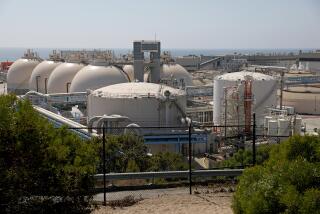Another View on Plant Expansion
- Share via
Another view of the Hyperion plant expansion project (Times, July 26) must be considered before this additional and unnatural filling of Santa Monica Bay proceeds.
Sand volume along the beaches and into Santa Monica Bay is at record high levels. Significant erosion of sand from the shoreline has not been observed in the past 40 years and a steady accumulation of sand has occurred over this period. Most of the accumulation has been artificial, resulting from the dredging of the Playa del Rey-El Segundo sand dunes for the construction of the Hyperion plant in the late 1940s, the excavation for the Scattergood power plant and the construction and maintenance of Marina del Rey. All of these projects have occurred without adequate review of their impact upon the shoreline of the bay for environmental considerations.
Development in the drainage basin of Malibu Canyon has resulted in additional erosion and sand input to the bay as has development throughout the Santa Monica Mountains and in the drainage basin of Ballona Creek.
Dredging of the sand dunes introduces a different type of sand grain into the shoreline. These are wind-sorted sands and not sand sorted by transport processes in the ocean. These wind-sorted sands do not form long, tapering beaches, but instead they form short, sharp beaches with waves that crash with undiminished fury onto the sand (sand busters). Ferocious gutter rips result, which are a severe hazard to children and swimmers.
Hyperion needs the room to expand its treatment facilities and thus must find a way to dispose of the sand to accommodate additional treatment capacity at the site. However, the site will prove to be inadequate for the additional waste flow that will be directed to this site.
Southern California Edison needs protection for its generating station at El Segundo. Chevron needs protection for its under-beach and underwater transmission lines for oil received at its offshore terminal. Chevron built a groin at the site under consideration without opposition from Southern California Edison, and Chevron dredged offshore for sand to build a beach west of the groin. The promise was that the sand would then bypass the groin and protect the generating station from erosion. The bypass has not performed as promised. Edison is agreeable to additional encroachment into the tidelands for protection of their facility and at no cost to Edison.
The California Department of Fish and Game plans artificial reefs for Santa Monica Bay to enhance fishing without considering if additional sand input to the bay will bury these reefs, as has happened in the past.
Dredging for the Marina del Rey is postponed for the boating season, but the problem of dredge disposal is not resolved. Additional dredging of Ballona Lagoon is proposed with implied disposal of the sand onto the beaches at Playa del Rey. Additional dredging in Marina del Rey is in the planning stages for the Summa holdings to create additional marina capacity for boats.
In the short term, there is no demonstrated need for additional sand in Santa Monica Bay. In the immediate future, there is a need to decide what to do with what is considered to be an excess of sand in the wrong places, (such as) Ballona Creek, entrance to the marina.
There is an immediate need to resolve what is to be done at the Hyperion treatment plant. This project only begs for time in which to come to grips with the real question of where and how are the additional waste flows of the City of Los Angeles and the seven cities that contract with L. A. for sewage disposal to deal with their increases in waste flow.
There is a long-standing need to come to grips with the problem of Santa Monica Bay itself as an environment which serves tens of millions of visitors per year. Part of this consideration must be to determine if wider beaches as a result of artificial changes in the shoreline are desirable and what this means to the safety of the public using these beaches as well as the effects upon the marine organisms that reside in the coastal habitat.
Not one of the above points were touched upon in the report published, nor do they appear to have been considered in the planning and advocacy of the proposed project.
RIMMON C. FAY
Venice
More to Read
Sign up for Essential California
The most important California stories and recommendations in your inbox every morning.
You may occasionally receive promotional content from the Los Angeles Times.











![Vista, California-Apri 2, 2025-Hours after undergoing dental surgery a 9-year-old girl was found unresponsive in her home, officials are investigating what caused her death. On March 18, Silvanna Moreno was placed under anesthesia for a dental surgery at Dreamtime Dentistry, a dental facility that "strive[s] to be the premier office for sedation dentistry in Vitsa, CA. (Google Maps)](https://ca-times.brightspotcdn.com/dims4/default/07a58b2/2147483647/strip/true/crop/2016x1344+29+0/resize/840x560!/quality/75/?url=https%3A%2F%2Fcalifornia-times-brightspot.s3.amazonaws.com%2F78%2Ffd%2F9bbf9b62489fa209f9c67df2e472%2Fla-me-dreamtime-dentist-01.jpg)

